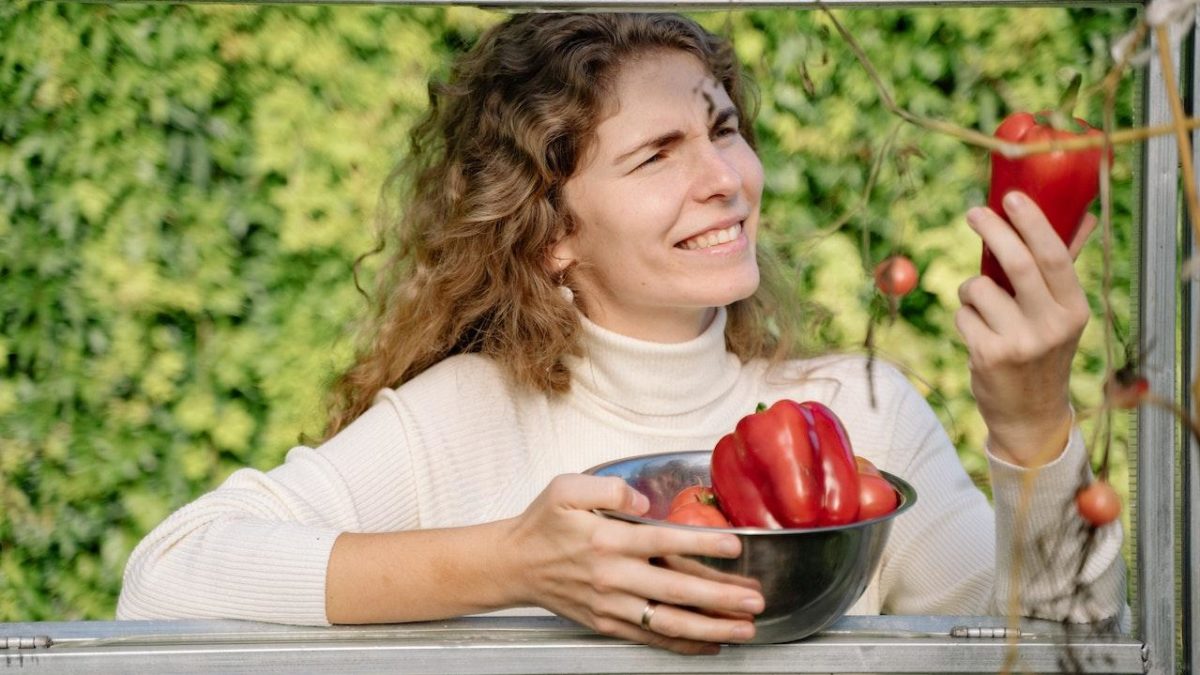If you’re looking for tips on how to keep your bell pepper plant healthy and happy, then look no further! In this blog post, we’ll share six tips that will help you get all the information you need to know about your plant.
“The best way to take care of your bell pepper plant is to keep it healthy and happy.”
How To Care For Bell Pepper Plants
Bell pepper plants are very easy to care for and add life to your home.
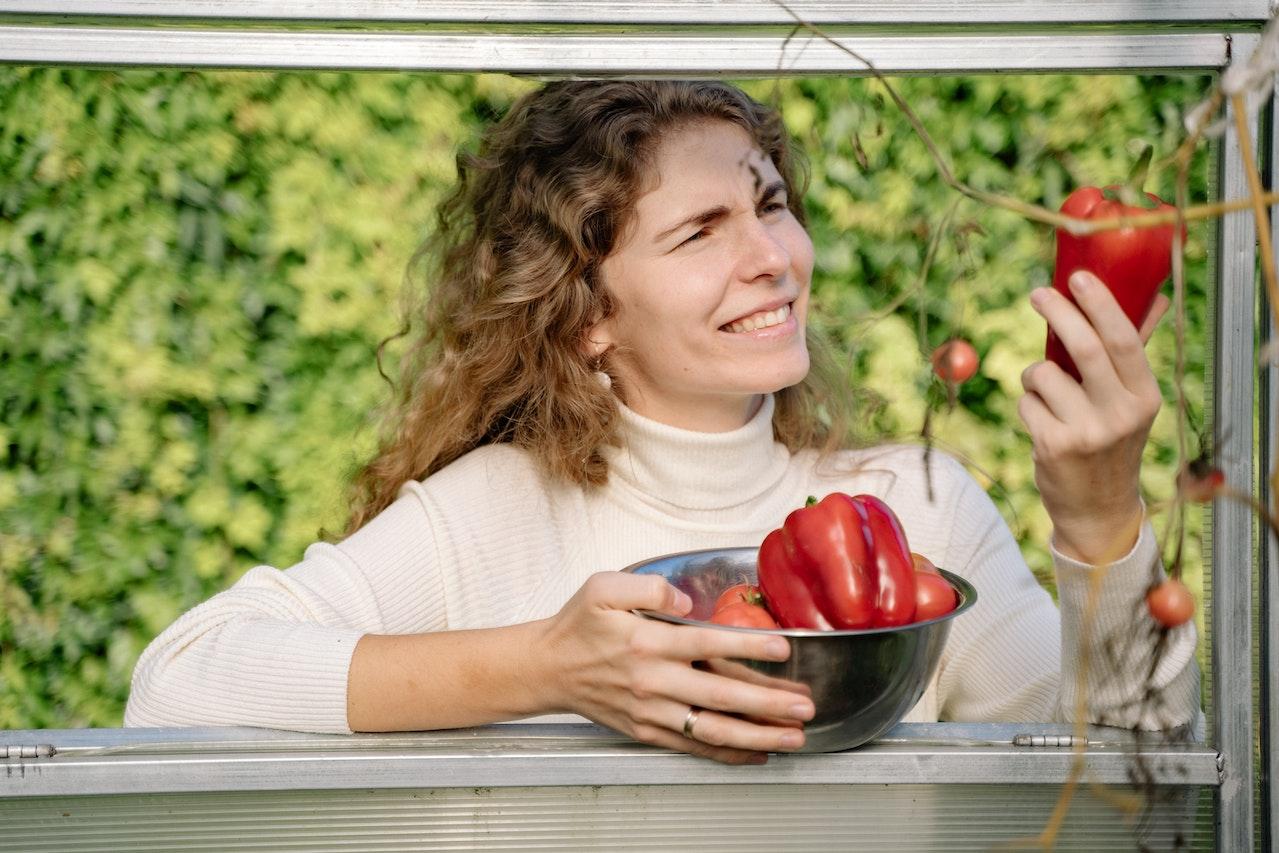
Credit: Pexels
To properly care for your bell pepper plant, you must learn a few things.
- Water requirement of the plant
- The right type of pot
- The right potting mix
- The best location for the plant
- How to fertilize the plant
- Common pests and diseases of the plant.
How Much Water Does A Bell Pepper Plant Need
Indoor plants are a great way to add some life to your home. But if you’re new to plant care, you might be wondering how much water and how often they need water.
Bell pepper plants in pots need to be watered regularly, about once a day or every other day. The soil should be moist but not soggy, and the plant should be watered at the base, not from above.
If the leaves start to droop, that means the plant needs more water.
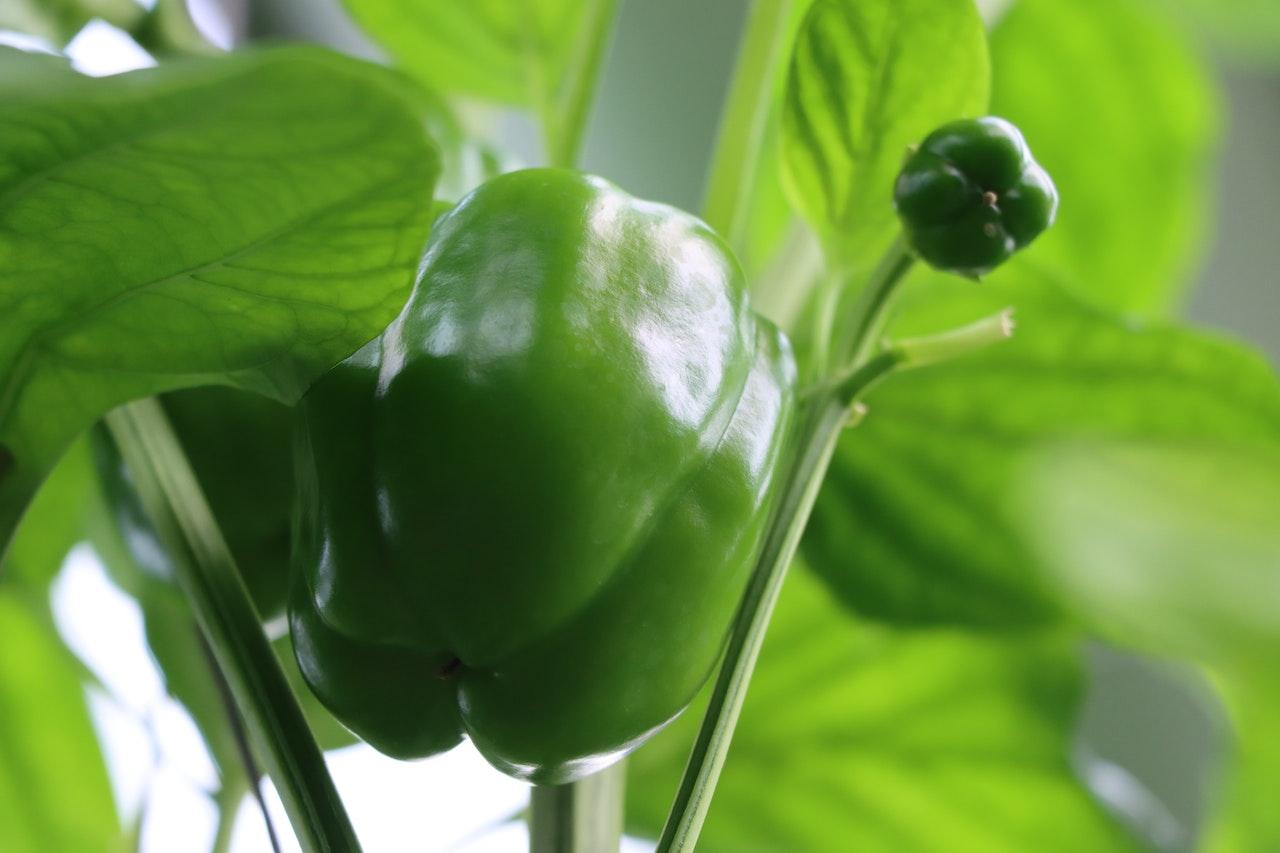
Credit: Pexels
Here are some guidelines about bell pepper plants:
- In general, you should water bell pepper plants in pots once a week, giving them enough water so that the soil is moist but not soggy.
- If the pot is small or the plant is in a hot, sunny spot, you may need to water more often.
- If the pot is large or the plant is in a cool, shady spot, you may need to water less often.
- Finally, if you’re not sure whether or not to water, it’s better to err on the side of too little water rather than too much. Over-watering can lead to root rot, which can kill the plant.
So there you have it! A general guide to watering bell pepper plants in pots.
Remember that the best way to figure out how often to water is to check the soil regularly. Put your finger in the soil up to the first knuckle. If the soil is dry, it’s time to water. If the soil is wet, wait a few more days before watering again.
Remember, these are just guidelines. With a little patience and practice, you’ll be a pro at watering your bell pepper plants in no time!
How Often Should You Water Bell Pepper Plants In Pots
It is important to keep bell pepper plants in pots well-watered, but you should be careful not to over-water them.
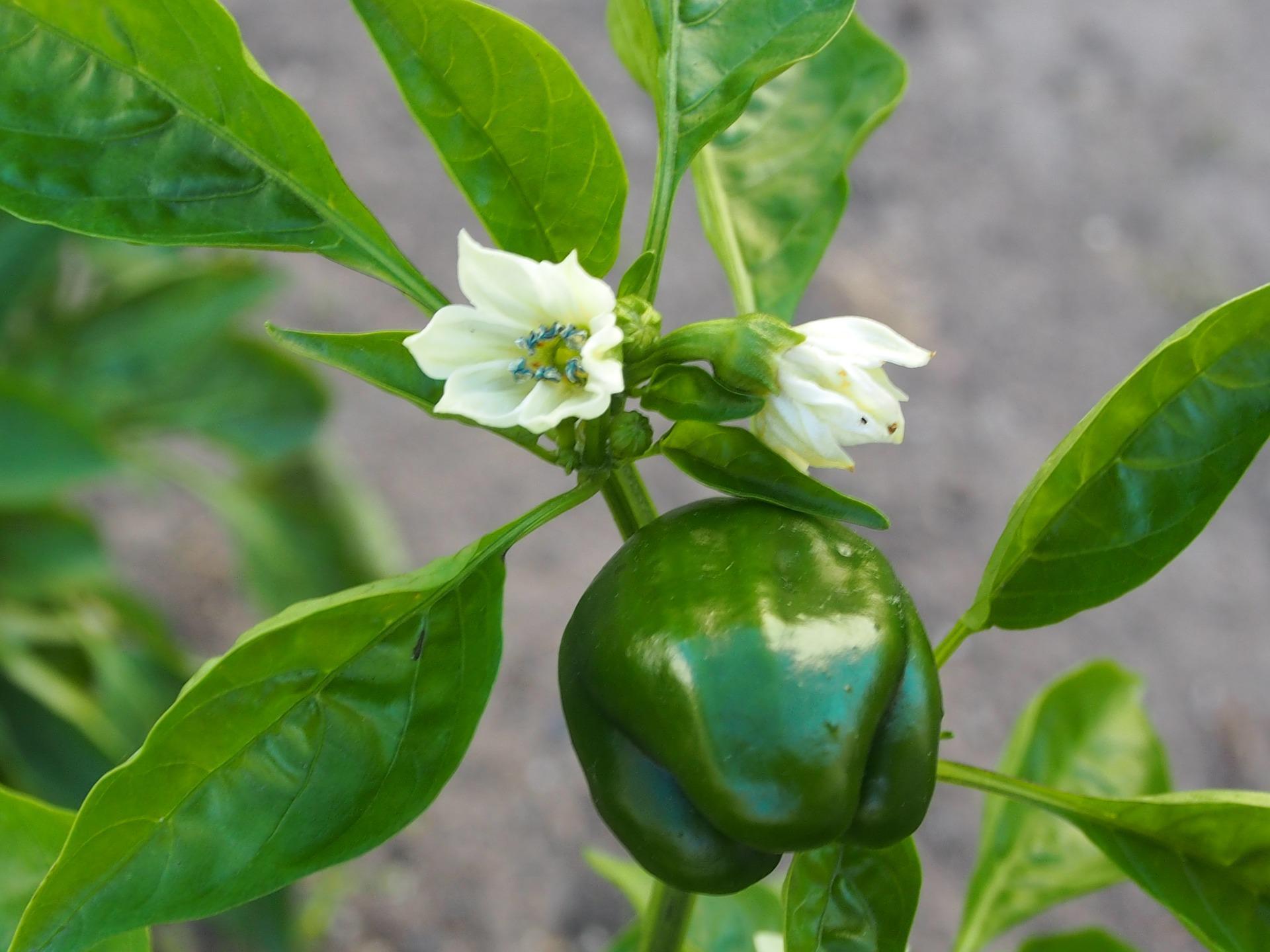
Credit: Pixabay
The frequency with which you need to water will depend on several factors. Here are a few things to keep in mind when watering your bell pepper plants:
- The size of the pot
- The type of potting mix
- The climate
- The stage of growth
1. The Size Of The Pot
The size of the pot will affect how often you need to water the plant. A small pot will dry out more quickly than a large one. Here are some general guidelines for how often to water bell pepper plants in pots:
- Small potted plants (6 inches or less) need water every 3-4 days.
- Medium potted plants (6-12 inches) need water every 5-7 days.
- Large potted plants (12 inches or more) need water every 7-10 days.
2. Type Of Potting Mix
The type of potting mix you choose can also determine how frequently you need to water. A mix that mostly contains sand will dry out more quickly than one with peat.
3. The Climate
The climate you live in will also affect how often the plant needs water. If you live in a hot, dry climate, you will need to water more often than if you live in a cool, moist climate.
4. The Stage Of Growth
Finally, the stage of growth of your plant also affects its water demand. A young plant that is just starting to grow will need more water than an older plant that is already established.
5 Signs Of Overwatering In Bell Pepper Plants In Pots
Here are some signs of overwatering in bell pepper plants in pots:
- The plant will start to produce fewer fruits.
- Leaves of the plant will begin to turn yellow and fall off.
- The stem of the plant will start to rot.
- Roots will begin to rot.
- The plant will eventually die.
5 Signs Of Underwatering In Bell Pepper Plants In Pots
Here are some signs of underwatering in bell pepper plants in pots:
- The leaves of the plant will start to turn brown.
- The leaves of the plant will start to fall off.
- The stem of the plant will begin to wilt.
- Roots will begin to dry out.
- The plant will produce fewer fruits.
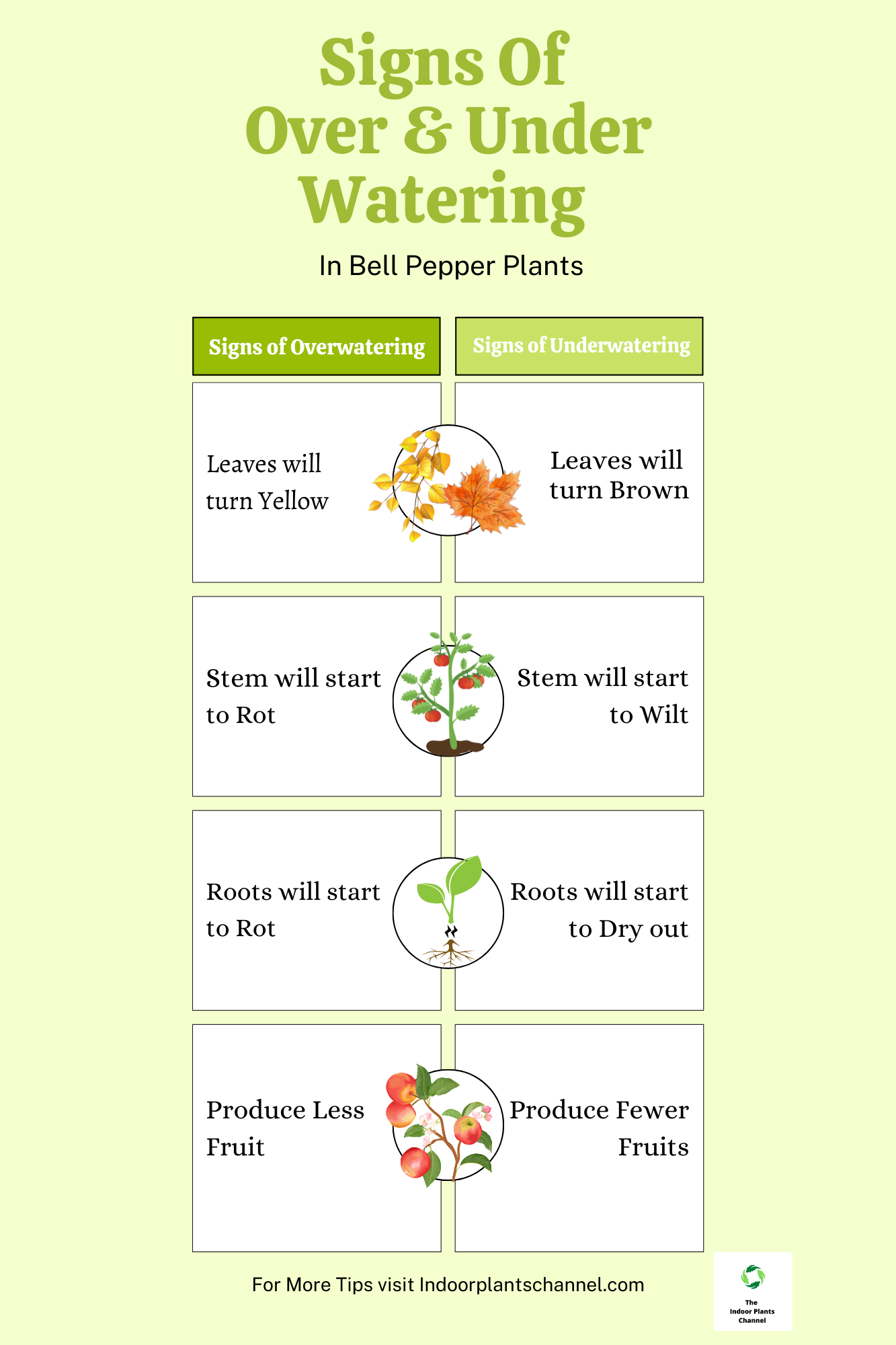
The Best Time Of Day To Water Bell Pepper Plants In Pots
If you are growing bell peppers in pots, it is important to water them regularly. However, it is also important to know when the best time of day to water them is.
The best time to water bell pepper plants in pots is in the morning. This is because the plants will have time to absorb the water before the heat of the day sets in. Watering in the evening can also be beneficial, but be sure not to water too late, as this can encourage fungal growth.
The Best Type Of Pot For Bell Pepper Plants In Pots
There are a few things you should keep in mind when choosing the best type of pot for your bell pepper plants.
- The pot should be big enough to accommodate the roots of the plant and the plant should be able to grow to its full size in the pot.
- The pot should have a drainage hole in the bottom so that the plant does not sit in water.
- It should be made of a material that allows the roots to breathe, such as terracotta or plastic.
The Best Potting Mix For Bell Pepper Plants In Pots
When it comes to potting mix, there is no one-size-fits-all solution for bell pepper plants. The best potting mix for your bell pepper plant will depend on the plant’s specific needs.
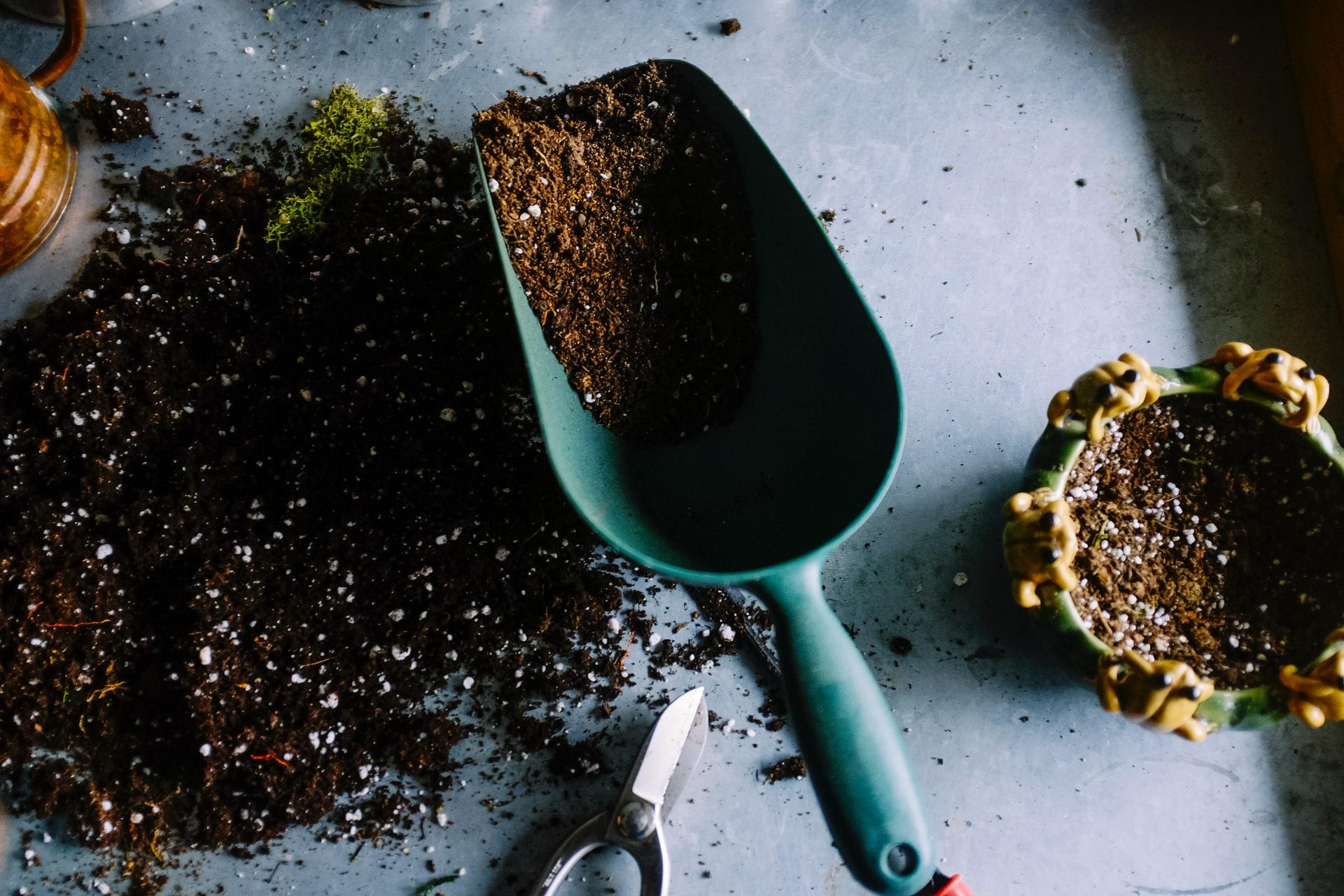
Credit: Unsplash
To determine the best potting mix for your bell pepper plant, consider the plant a few things.
1. Well-Drained Soil
Bell pepper plants need well-drained soil, so a potting mix that is too dense or too wet can be problematic. To improve drainage, mix in some perlite, vermiculite, or sand.
2. Lightweight And Airy
The potting mix should also be lightweight and airy. A lightweight potting mix will help to prevent the plant from becoming waterlogged. To lighten the mix, add some sphagnum peat moss or coco coir.
3. Slightly Acidic
Finally, the potting mix should be slightly acidic. A pH of 6.0 to 6.5 is ideal for bell pepper plants. If you’re not sure about the pH of your potting mix, you can test it with a pH test kit.
The Best Location For Bell Pepper Plants In Pots
- Place your bell pepper plant in a pot that is at least 12 inches wide and deep.
- Choose a location for your pot that gets full sunlight for at least six hours per day.
- If you live in a hot climate, try to find a spot that gets some afternoon shade.
- Make sure the location you choose has good drainage.
- Water your bell pepper plant regularly, and make sure the soil stays moist but not soggy.
How To Fertilize Bell Pepper Plants In Pots
It is important to fertilize bell pepper plants in pots because they are not able to get the nutrients they need from the soil. There are a few things to keep in mind when fertilizing bell pepper plants in pots:
- Use a fertilizer that is high in phosphorus. Phosphorus is essential for plant growth and helps the plant develop strong roots.
- Apply the fertilizer to the soil around the plant, not directly to the plant itself.
- Water the fertilizer into the soil so that the roots can absorb it.
- Do not over-fertilize the plant, as this can damage the roots.
Following these tips will help you fertilize your bell pepper plants successfully and ensure that they are healthy and productive.
The Common Pests And Diseases Of Bell Pepper Plants In Pots
Pests and diseases can be a big problem for bell pepper plants in pots. Here are some of the most common ones to watch out for:
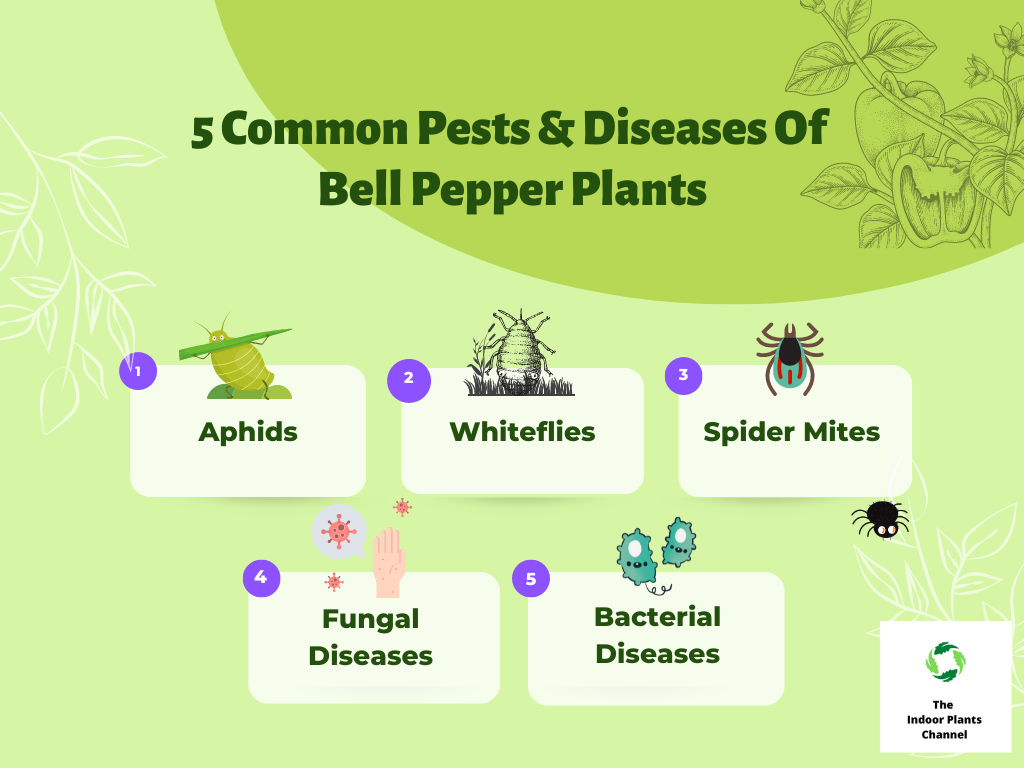
1. Aphids
Aphids are small, soft-bodied insects that feed on the sap of plants. They can cause a lot of damage to bell pepper plants, especially if there are a lot of them. Signs of aphid damage include leaf curling, stunted growth, and yellowing leaves.
2. Whiteflies
Whiteflies are small white insects that suck the sap out of plants. They can cause a lot of damage to bell pepper plants, especially if there are a lot of them. Signs of whitefly damage include leaf curling, stunted growth, and yellowing leaves.
3. Spider Mites
Spider mites are tiny spider-like creatures that feed on the sap of plants. They can cause a lot of damage to bell pepper plants, especially if there are a lot of them. Signs of spider mite damage include leaf curling, stunted growth, and yellowing leaves.
4. Fungal Diseases
Fungal diseases can be a big problem for bell pepper plants. Some of the most common ones include powdery mildew, black spot, and Alternaria. These diseases can cause leaf spots, stunted growth, and even death in severe cases.
5. Bacterial Diseases
Bacterial diseases can also be a big problem for bell pepper plants. Some of the most common ones include bacterial leaf spots and bacterial canker. These diseases can cause leaf spots, stunted growth, and even death in severe cases.
The best way to prevent pests and diseases from damaging your bell pepper plants is to keep them healthy and well-maintained. Make sure to water them regularly, fertilize them regularly, and keep an eye out for any signs of problems.
If you do notice any pests or diseases, be sure to treat them right away.
Expert Ideas
- Water bell pepper plants in pots every week
- Fertilize bell pepper plants in pots every month
- Prune bell pepper plants in pots every season
- Re-pot bell pepper plants in pots every year
Bonus Tip
Water your bell pepper plants in pots every week or so, depending on the size of the pot and the plant. Check the soil before watering to see if it is dry.
Frequently Asked Questions
1. How often should I water my bell pepper plants in pots?
It is best to water your bell pepper plants in pots once a week. Water them deeply, so that the water reaches the bottom of the pot. It will help to encourage deep root growth.
2. What happens if I water my bell pepper plants too often?
If you water your bell pepper plants too often, the roots will not get the chance to grow deep and strong. This can lead to the plant becoming waterlogged and eventually dying.
3. What will happen if I don’t water my bell pepper plants enough?
If you don’t water your bell pepper plants enough, the roots will not be able to get the moisture they need to grow. This can lead to the plant becoming stunted and eventually dying.
4. How can I tell if my bell pepper plants need watering?
The best way to tell if your bell pepper plants need watering is to stick your finger into the soil. If the soil is dry, then the plants need watering. If the soil is wet, then the plants do not need watering.
5. What is the best time of day to water my bell pepper plants?
The best time of day to water your bell pepper plants is in the morning. It will give the plants time to absorb the water before the hot sun dries them out.
Conclusion
If you follow these six tips, you will be well on your way to growing a healthy and productive bell pepper plant. With a little care and attention, you can enjoy fresh bell peppers all season long.
Michelle Wilde
Related posts
![]()
About Michelle Wilde
Michelle Wilde is a stay-at-home mom and avid plant lover. Armed with a post-graduate degree in Computer Science (no kidding!), she loves researching plants and landscapes. When she is not caring for her 4 kids, she spends time on her passion for plants. She blogs at www.indoorplantschannel.com, the trusted source for indoor plants.
Learn more
Subscribe
* You will receive the latest posts and updates about indoor plants!
Search
Recent Posts
Categories
- Beginner Guides (10)
- FAQ (206)
- General (2)
- How-To Guides (212)
- Indoor Plants (214)
- Pest Management (2)
- Plant Problem Solutions (4)
- Seasonal Growing (2)
- Specialized Environments (2)
- Specific Plant Care (3)
- Technical Growing (2)
